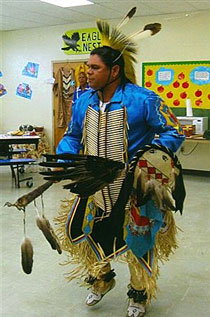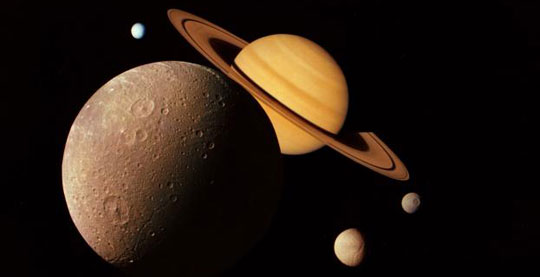UAB Scientist Offers New Views of Space
By Jennifer Ghandhi
More than 800 million miles from Earth, the space orbiter Cassini is busy shooting pictures of the planet Saturn and its moons. Thousands of these in-flight images are available online on Cassini’s home page—but the spacecraft’s oeuvre includes many recordings that cannot be appreciated with human eyes alone. They’re snapshots of data gathered by an onboard instrument called the Ultraviolet Imaging Spectrograph (UVIS), which records measurements of reflected UV light that is invisible to humans. On Earth, UV rays can be harmful, but in space, UV data is immensely useful to astronomers measuring the composition of distant planets.
Right now, NASA scientists don’t have a way to effectively interpret the UVIS data Cassini is relaying, so they’ve tapped UAB physicist Perry Gerakines, Ph.D., to help. He was awarded a three-year, $408,000 grant to create thin, icy films of materials thought to be on Saturn’s moons and then analyze them with a custom-built UVIS of his own. “We’re going to measure these spectra—the way different compounds absorb and reflect light—in the hopes that we can use them to interpret the spectra we see from the icy moons on the rings of Saturn,” Gerakines says.
UAB Team Tracks a Forgotten People
By Claire L. Burgess
 |
After years of isolation and poverty, Alabama’s MOWA Choctaw tribe is reclaiming its roots—with the help of UAB alumna Jacqueline Matte and UAB anthropologist Loretta Cormier. |
Thirty years ago, UAB alumna Jacqueline Matte went out to the Choctaw reservation in southwest Alabama in search of a story. What she found has haunted her ever since, fueling decades of interviews, investigations, and heartache. Nine years ago, UAB anthropologist Loretta Cormier, Ph.D., joined the struggle. Separately and together, Matte and Cormier have fought through swamps both literal and legal, seeking clues to one of the great vanishing acts in Alabama history. It is no easy task; after all, they are looking for a people who haven’t wanted to be found for more than 150 years.
The Alabama Choctaw lived in poverty and isolation until the 1940s, when they began sending some of their children to Indian schools in other states because their own were not accredited. When those educated children came home, they led the tribe out of isolation and into the public eye, launching a campaign for state recognition. In 1979, they officially became the MOWA Band of Choctaw Indians, the first recognized tribe in Alabama. (The name MOWA comes from the tribe's location on the Mobile County-Washington County line.) The following year, the tribe began to seek federal recognition, a lengthy and involved process requiring extensive genealogical research. That is where Jacqueline Matte comes in.
UAB Researchers Focus On New Clues to Macular Degeneration
By Bob Shepard
 |
Christine Curcio has studied age-related eye diseases throughout her 28-year career as an eye researcher. |
Oversized phone dials. Magnifiers. Little tricks with peripheral vision. There are many ways to cope with age-related macular degeneration (ARMD). Unfortunately, one of the most popular is denial.
“Half of my new patients at the UAB Center for Low Vision Rehabilitation want me to make them a new pair of glasses so they can go home and have everything the way it was before,” says UAB optometrist Dawn DeCarlo, O.D., the center’s director. “Many patients have no idea what ARMD really means.”
For a long time, even researchers didn’t know a great deal about this devastating condition. And even though they’ve made progress in recent years, they still face some maddening blind spots. The disease, as its name implies, is associated with aging, and it gradually destroys sharp, central vision. ARMD comes in two forms: wet and dry. The wet form, which affects about 15 percent of those with ARMD, leads to more severe vision loss, but its cause is reasonably well understood. In a process called neovascularization, abnormal blood vessels behind the retina grow into the macula, the center of the retina. These blood vessels can rupture and leak, damaging the macula by separating it from the rest of the retina. The good news is that there are new medications, called anti-VEGF drugs, that are extremely effective in treating the wet form of the disease.
UAB Uses Nutrition Science to Fight AIDS in Africa
By Tara Hulen
As medical mysteries go, this one is particularly heartbreaking. Several years ago, UAB clinicians began a large-scale program to bring lifesaving antiretroviral therapy to Zambia. But to their surprise, the same wonder drugs that revolutionized AIDS treatment in the United States produced untoward side effects in Africa.
Scientists at UAB’s Centre for Infectious Disease Research in Zambia (CIDRZ), which administers the program, were perplexed. “In the first 90 days, an unexpectedly large number of patients die after the drugs are started,” says Douglas Heimburger, M.D., a researcher and professor in nutrition sciences and medicine at UAB. “But if they can get through the first 90 days, the patients’ mortality rates are very similar to patients on similar therapies in the United States.”
UAB Neuroscientists Stretch the Boundaries of the Mind
By Bob Shepard

Image courtesy of J. Palop
The brain, as we saw in last week's story, is "plastic" in the sense that it can reshape itself after injury. But the power of plasticity doesn't stop there, says David Sweatt, Ph.D., chair of the UAB Department of Neurobiology, director of the Evelyn F. McKnight Brain Institute, and Evelyn F. McKnight Endowed Chair for Learning and Memory in Aging. According to Sweatt, the brain is also able to strengthen the connections between neurons—and even make new neurons.
Neurons, Sweatt explains, are the fundamental information-processing units of the brain. But they do not work in isolation; instead, each neuron communicates with thousands of its neighbors through specialized connections called synapses. “It turns out that perhaps half of the synapses in the adult nervous system have a robust capacity to change the strength of the connections between neurons,” Sweatt says. “That is an important part of how the brain works, how we store information, and how we adapt to environmental stimuli.”
It is also an important part of memory, says Sweatt—in fact, he argues, synapses are the keys to memory. And once scientists understand how the adult brain strengthens certain synapses, they can begin to manipulate the process—finding ways to slow down or delay the inevitable memory loss associated with aging.
